Two Tucson youth cyclists attended the country’s first Youth Bike Summit this weekend.
In a recent post, Donovan Caputo and Ashley Batchelor shared their experiences in New York.
Below is BICAS education co-coordinator Kylie Walzak’s own experience from the summit. Walzak said she hopes to organize a Youth Bike Summit for young people in the Southwest.
1. The part of the summit I liked best was… because..
The part of the summit I liked best was the first session I attended which was about giving youth tools for advocacy. Two different New York advocacy groups were featured: Velo City and Transportation Alternatives (TA). Both are based in New York and both work with youth, although TA works with them indirectly by involving them in action campaigns whereas VeloCity works with them directly with internships. VeloCity spoke first and talked about the Bike Splorations program. This is a youth-led summer bike tour program where youth leaders — after a six week training period — take other youth bike participants around the city and engage the tour riders in a variety of activities. Some of the activities include Green Mapping, attending festivals, visiting museums, supporting farmers’ markets and swimming in dumpster pools. Green mapping is an activity that involves riding to and marking places with bike friendly facilities, parks, swimming pools, farmers’ markets or other places where local fresh food is available. I liked this group’s presentation because of the high level of youth involvement and I like the group’s summer activities because I think it would be a good program to model our summer bike camps after.
The second group to present was Transportation Alternatives. This is an advocacy group that has been working with Brooklyn residents on a campaign to make the borough’s largest park – Prospect Park – car-free. Currently the park allows cars to drive through it for commuter purposes. Over 30 years ago residents near the park wanted to make it car-free. Last summer TA got youth involved in the campaign. Some of the strategies the youth worked on included data collection, organizing a postcard/letter signing campaign, street theater, and organizing a march from Brooklyn to city hall to deliver the 10,000 signed postcards to Mayor Bloomberg.
I liked the data collection aspect best of this campaign. The youth gathered real, irrefutable data on noise level in the park with and without cars using decibel meters and recorded the average speed of cars through the park using radar guns. The photos of students using radar guns to measure car speeds, then holding up signs telling cars “You Are Speeding” when they were measured above 30 mph were really powerful. In such an uber-urbanized setting where kids have so few options for outdoor play, it was a stark reminder that these kids had to put up with some rather dangerous situations in the park when they wanted to play or relax there.
I also liked the organized march to Mayor Bloomberg’s office. The youth invited a local marching/stepping band to join them along the bridge and draw attention to their campaign. When they got to city hall the marchers filled a cardboard box with the 10,000 signed postcards the group had collected. City Hall in New York is heavily guarded and fenced in. When the march arrived, kids gave speeches and the marching band played before they went inside to talk to the mayor. One youth was overheard saying “I can’t believe they let us in here.” This was both an unbelievable and remarkable comment. What I took away from that was the youth was remarking on how City Hall was so heavily guarded yet they could just walk in and ask to have their voices heard — and they had to be heard.
The campaign was somewhat successful. By the end of the summer, the youth managed to get the mayor to agree to close down two of four of the park’s entrances to cars and limit the other entrances to peak commuting hours only. The struggle continues but it was exciting to see the enthusiasm of youth who participated, to see their understanding of the democratic process expand and become tangible for them, and to see their pride at having affected real change in their community.
This presentation was truly inspirational for me in thinking about ways to get youth involved in civic participation, government, and community improvement.
2. I found out about these three organizations, in these communities, and this is what they do…
I met Pasqualina, Executive Director of Recycle-A-Bicycle and friend of BICAS; Kimberly White — she accompanied Pasqualina and others as a youth delegate to the National Bike Summit in D.C. last year; Jackie – an extremely nice lady from Staten Island who expressed her deepest sympathies for all of Tucson in the wake of the tragedies last week; Karen Overton, founder of Recycle-A-Bicycle and a very close friend of BICAS founding member Kim Young; Andrea from Free Ride in Pittsburgh and Liz Clarkson from Chicago. I know that’s a lot more than three people, but I met so many inspirational people from so many different places that are of special note.
I found out about Bikes not Bombs, which operates all over the world but has a hub in Boston, and sends bikes to other countries where bikes are needed.
3. I like New York City because…
Because of how diverse it is and because of how active and motivated the youth are to be involved in community issues. In a city of 8 million people I was really surprised to see how few people were working on bike issues, but understood how they managed to have such a huge impact on the city infrastructure when I saw how all kinds of different organizations — ones that deal with environmental issues, resource access and equity, diversity advocates, urban and landscape planning — worked together to achieve goals that helped further all of their missions. An example that comes to mind: several environmental organizations were present at the summit and some of them didn’t have anything to do with bikes directly. Yet, the goal of seeing more people ride bikes makes sense from an environmentalists perspective when you think of the reduction in greenhouse gases, traffic congestion, and obesity rates that cycling can help realize. I think in a city as big as New York you learn a lot more quickly how and why it is important to work together, even if your missions don’t entirely align. It’s organize and work together or get swallowed alive in this big city.
4. However, I didn’t like…
I didn’t like the stark reminders of the viciousness and pervasiveness of capitalism and consumerism once we stepped out of the Summit workshops. Everywhere we went on Saturday night, as we walked through the most tourist heavy parts of the city, I was reminded of how much work we have to do in order to change the collective American culture of consumption and resource accumulation. Be that as it may, we did have a delicious dinner and an even more delicious piece of cheesecake to celebrate Donovan’s birthday on Saturday night and that was very lovely. We also had a great time walking around and seeing New York’s impressive architecture, shops, and entertainment centers. Still, excess is everywhere in New York and that is frightening to think about in too much detail.
5. Sunday was the conclusion of the summit and the organizers had us write down one issue we are most passionate about. My issue was…
How to increase ridership numbers in Tucson.
6. Then the organizers put us into groups according to the similarity of our issues. In the group we brainstormed five action items that we can take to address those issues. Those five items were…
I was put into a group with the largest number of people. We had all listed a bicycle advocacy issue as our biggest concern. We had three youth participants in our group who lead our discussions which centered around how to get more students to ride their bikes to school. The five action items we brainstormed were:
a. Get bike riding to be an acceptable form of transportation to and from school and acceptable physical education activity.
i. As a sub action item our first step in making this happen is to have our organizations meet with faculty, staff, administrators and parents of school-age children who could ride to school.
b. Create surveys and talk with parents to find out exactly what prevents people from allowing their kids to ride to school. In some cases it is the administration who prevents it, so working with them is essential to find compromise.
c. Create incentives with local, bike-friendly businesses to encourage more students to ride to school. Earn-a-sandwich, earn-a-bike, etc.
d. Work to create more networks and more accessibility to classes that teach youth how to ride and how to ride safely.
e. Lobby for safe routes to school, complete streets, and more bicycle facilities. Bring youth stakeholders to meetings where important decision are being made to engage them in government decision making processes.
7. What changes would I make to the summit for Tucson? What things would I keep?
For the summit in Tucson I would like to see more kids. Seeing as this was the first ever youth summit, in New York or anywhere, I think it was good that there were so many adults to help the kids navigate the issues and the fear of presenting to large crowds. Yet, I left feeling like I didn’t really get to hear kids’ voices in all of this. In a lot of ways it’s a chicken or egg kind of question — do you get kids excited about bikes first then hope the advocacy issues interest them, or do you get them motivated about all the advocacy work to be done then introduce them to bikes as a means of addressing things like environmental sustainability, traffic congestion etc. It wasn’t clear to me in New York which method was working best and there was a good mix of both approaches. In Tucson we clearly are in the business of getting kids excited about bikes first, but I feel the advocacy piece is missing all together. I’d like to see advocacy be the focus of the Tucson summit but with lots and lots of bike riding as well.
8. Would I ride my bike in New York City? How would I ride differently in the city and what kind of bike would I ride?
Much like how I ride in Tucson, I would stick to bicycle friendly facilities on New York streets even if that meant having to go out of my way to get to my destination. I couldn’t believe the kinds of unsafe riding and driving practices I saw in New York. On our way out to the airport to leave, we had the good fortune of riding in a cab with a driver who was both very opinionated and very informed on bike issues in New York. As a cab driver it was very interesting to hear his opinions on sharing the roads and the new facilities Janette Sadik-Khan and her teams are implementing. His solution was quite generous even though his feelings towards cyclists were not! He proposed to us — in the cab — that the Transportation Commissioner should designate a certain number of avenues — which run north and south in Manhattan and are one way — and turn one entire lane into a separate bike lane. In a certain sense this is already happening, but not enough for the driver. His conclusion was that bikes and cars cannot share the roads because of the size and acceleration differences. He told us stories of bike messengers who carried chains wrapped around their knuckles and would smash the right side rear view mirrors of cabs as their only means of recourse against cars that wouldn’t give them enough space on the road. “Oh my God, if I could tell you how many mirrors I have replaced because of bike messengers…” he told us.






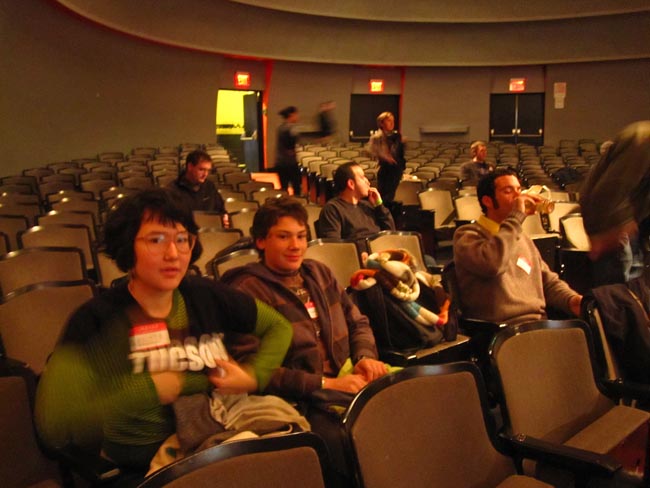



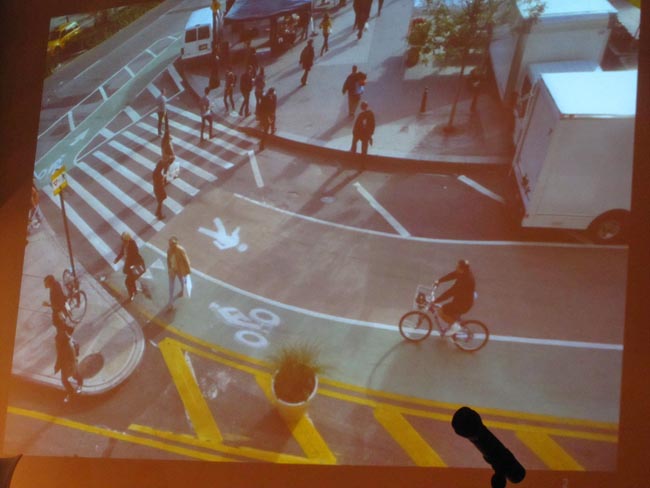

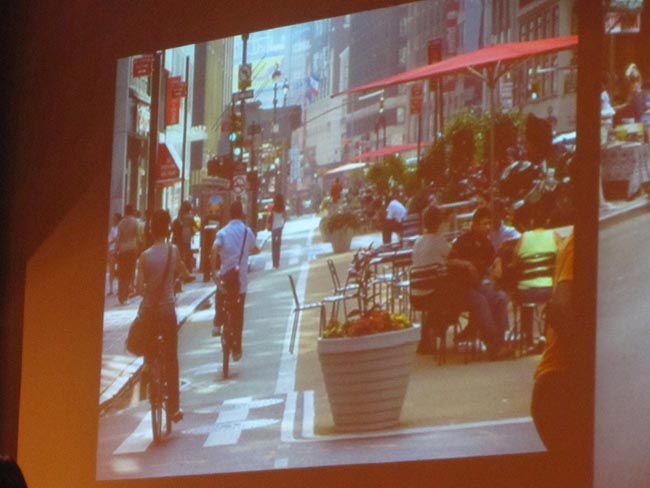



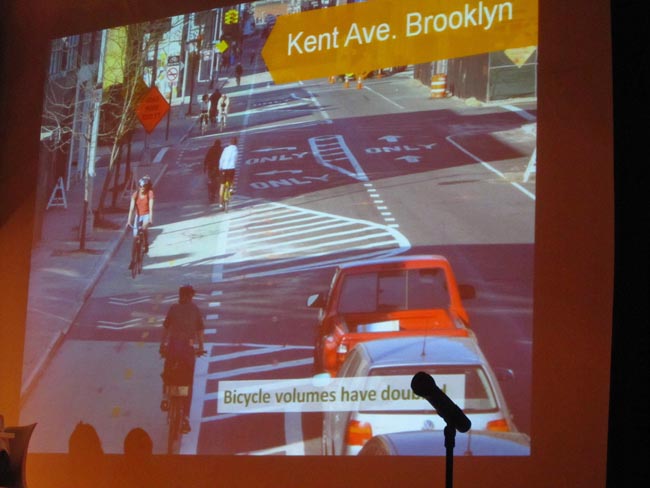





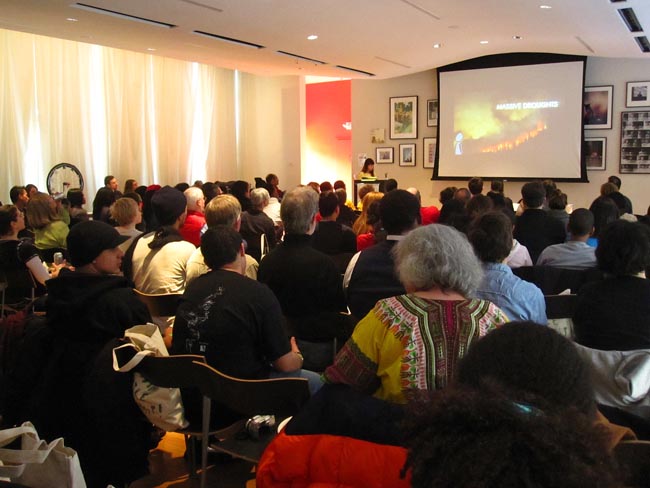

















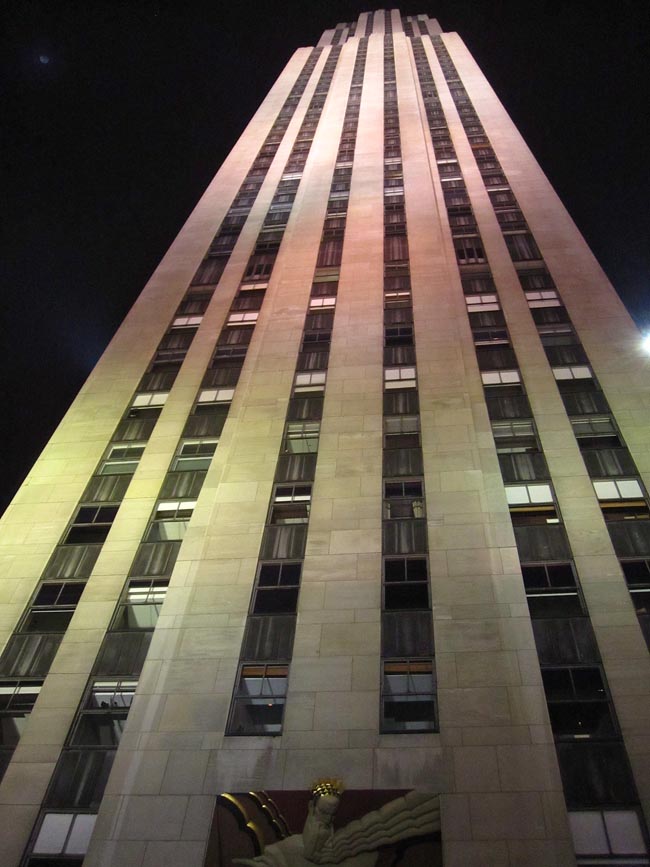












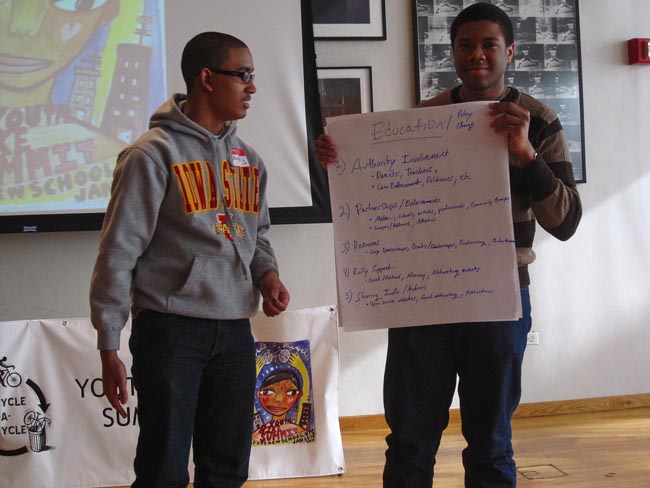
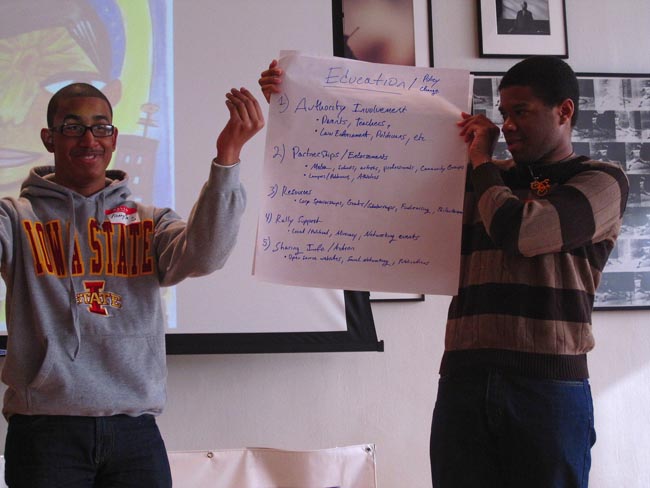





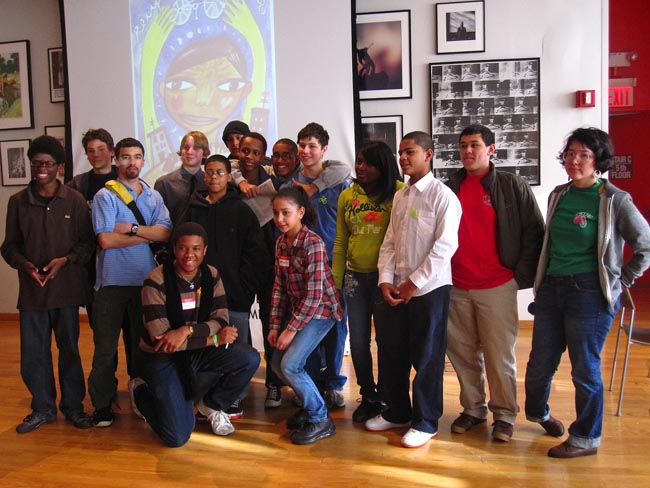

hanks for the reporting on this Mike. What a great opportunity for the youth and ultimatley for us as a community to learn from their experience moving forward. Exciting stuff!